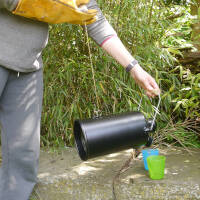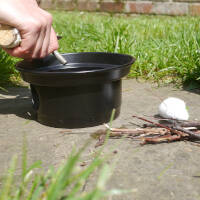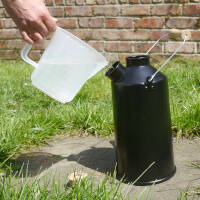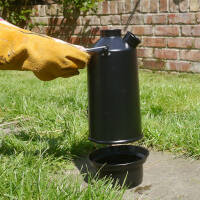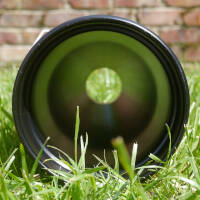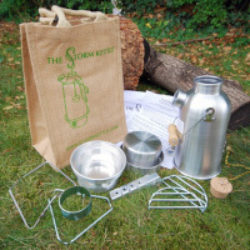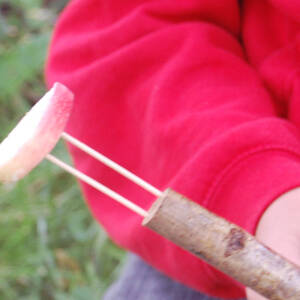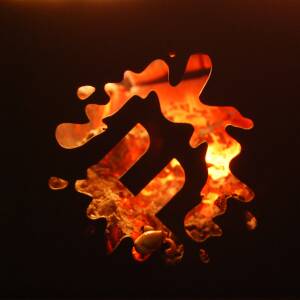Storm Kettles guide
Using a storm kettle
A step-by-step guide to using a storm kettle aka Kelly kettle.
Scroll to the bottom to download our free pdf: Step-by-Step Guide to Using a Storm Kettle.

Introduction
Storm kettles are often referred to as Kelly kettles or volcano kettles.
In the early 1900s, in the western part of Ireland, crofters made a simple water boiler using hand tools. They were normally made of copper and took many hours to make.
These water boilers were also used in the summer months to easily and quickly boil water for tea, by enthusiastic fishermen who visited Ireland regularly to enjoy the splendid fishing.
In the early 1970s John Grindlay (of the Eydon Kettle Company) and his colleagues decided to manufacture the kettles in quantity, so that they could be made available to outdoor enthusiasts all over the world. John borrowed an original copper kettle and took it to England where tooling was manufactured and the first ten kettles were produced. These were very quickly sold, for £10 each, in 1979.
Today, John still produces the storm kettle in the UK and they are used on all continents of the world. The storm kettle has quickly become a vital and important piece of kit for all outdoor enthusiasts, survival and bushcraft experts.
What you'll need
This activity has been provided by

Useful items from our shop
Environmental Considerations
Consider the environmental impact of preparing, carrying out & completing this activity. Could this impact be reduced? Specific considerations for this activity could include:
- fire pit site – permission from landowner
- source of kindling
Health & Safety Considerations
Follow your usual operating procedures and carry out appropriate risk benefit assessments.
Some considerations particular to this activity include:
- fire safety
- hot metal
- hot water
- supervision of use of storm kettle
- DO NOT boil with the cork in as pressure can build up and cause explosion
- stable positioning
What is a storm kettle?
The storm kettle is a water heater that uses twigs and other materials easily found in woodland as fuel. Using a storm kettle means you can boil water easily, in the wettest and windiest of weathers, both rapidly and safely.
Its structure is a water-jacketed double-walled aluminium chimney with a removable aluminium fire pan. A small fire is built in the pan, the water-filled chimney is placed over the fire, and the fire heats the jacketed water. The heating process is speeded up by the draw effect of the chimney pulling air in the bottom and feeding the fire in the base.
These kettles are an excellent way for groups to observe many aspects of the fire triangle (heat, fuel, oxygen), fuels, heat, convection, radiation, chimneys, boiling temperatures of water, etc, whilst producing a lovely hot brew at the same time.
Storm kettles come in two sizes, the Original and the Popular. The Original will boil up to 2.5 pints (approx. 1.5 litres), the Popular up to 2 pints (approx. one litre).
Preparation:
Clear the immediate area around the kettle - to prevent surrounding materials catching alight through direct contact with flames or through heat radiation.
Find a stable position - due to the small base area and high centre of gravity, when these kettles are full they can easily become unstable, topple over and cause injury. To prevent this from happening:
- prepare a level, stable position to sit the base upon
- ensure that the kettle is not knocked or banged during use.
Increase oxygen - position the base so that the hole is facing towards any wind.
Collect all required materials - tinder, kindling and fuel, and place your tinder into the base of the kettle making sure you can access the hole to light the fire through.
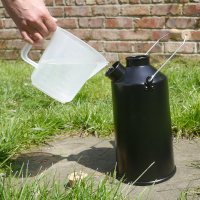
Fill the kettle - pour the correct amount of water into the spout (if too full it will bubble over when boiling).
Place the kettle on the base securely - ensure no debris is caught in the rim which will make it unstable.
Alternatively the fire can be lit in the base first, then the kettle placed on to it and fuel added through the top.
Warning: boiling the kettle with the bung in can be dangerous.
Additional safety considerations:
Group safety rules - ensure roles have been allocated to group members and that everybody is clear about the safety rules.
Safety distance - everyone should remain outside an agreed safety zone except for the people tending the fire. The zone needs to be big enough to ensure that the kettle or the people tending the kettle will not be knocked into.
Movement near the kettle - people tending the kettle should be knelt down at all times, except for when moving away. To do this they should move back and stand up, then back out of the zone, away from the kettle.
Communication - the people tending the kettle need to inform each other clearly of what they are about to do.
Pressure - always check that the cork bung has been removed before heating the water. If the bung is left in pressure can build up in the kettle causing the bung to fly out, spraying boiling water or making the kettle topple over, which both have the potential to cause serious injury.
Warning: boiling the kettle with the bung in can be dangerous. Check again before you start!
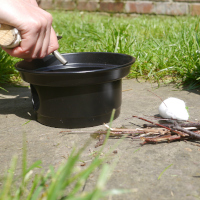
Lighting the kettle:
With a fire steel
If you are using a fire steel to light the fire, fill the base with tinder and use the steel or another ignition source directly onto the tinder in the open base. Once this has caught add more tinder and then gradually add kindling. Once a very small fire has been established put the kettle over the fire. Check there is no debris in the rim and beware of any heat rising through the hole towards the handle.
With matches
Alternatively, if you are using matches, set up the tinder in the base and place the filled kettle in position. Then light the tinder in the base through the hole. Gradually add kindling through the hole in the top of the kettle, making sure each piece catches alight. Once the kindling is burning well add the fuel. Make sure that all fuel is short enough to drop into the cavity and is not poking up through the hole.
Warning: never look directly down the chimney to see if the fire is burning as hot air and ash may cause burns to eyes and face.
Boiling water:
When the kettle starts making a strange gurgling noise or you can see the water bubbling near the spout this indicates that the water is boiling.
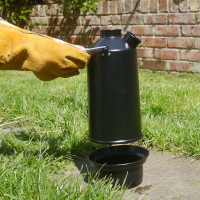
Removing the kettle from the base:
This is a potential time for injury so take care.
Using protective fire gloves, take hold of the carry handle with one hand and swiftly lift the kettle off the base. Watch that the base doesn’t stick to the kettle.
Alternatively hold the carry handle with two hands at a right angle to the kettle and lift it off.
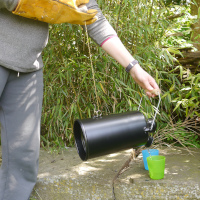
Pouring the water:
Line the cups/pans up on stable ground. Do not hold cups when pouring as spillages could cause burns.
Check the chain is cool enough to touch as it often gets hot.
Using heat resistant gloves, hold the carry handle in one hand and pull the chain up with the other, this will tip the water out of the spout into the cups.
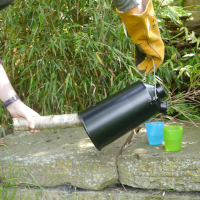
If the chain is too hot to touch or has been removed, use a strong stick placed inside the bottom of the chimney, with your hands well away from the kettle, and use this to lift the bottom of the kettle up and pour the water.
Handy hints:
Oxygen - you can assist the fire by gently blowing through the hole to increase the amount of oxygen reaching the fire. Make sure you are not too close to the kettle and there is no potential for the kettle to fall onto you. As the fire heats it should naturally rise up through the chimney, drawing air into the base through the hole, automatically feeding the fire with oxygen.
Aluminium - is lightweight, but it is a relatively soft metal that can easily be dented if not maintained correctly. Poor maintenance can lead to the base staying attached to the chimney when taking the boiled water off the heat. This could cause the person carrying the kettle to have their hand over the heat for a sustained period.
Bung - keep the bung in the kettle when not in use, to prevent dirt and debris getting into the water compartment.
Base - when not in use, turn the base upside down – it fits neatly into the main chimney for easy transportation and storage.
Avoiding burns - to reduce the chance of the bung being used when heating water, and the risk of burns from the chain, some people choose to remove the bung and chain completely. If you do this you must set up a safe alternative for pouring the water.
Download our free Step by Step Guide to Using a Storm Kettle here
Disclaimer: Muddy Faces cannot take any responsibility for accidents or damage that occurs as a result of following this activity.You are responsible for making sure the activity is conducted safely.
Key Features
- Age Range 6+
- Duration Less than an hour
- Location Anywhere
- Season Any
- Time of Day Anytime
-
Categories:
Fire, Shelters & Bushcraft
fire
Food Outdoors
campfire cooking
Activity Downloads

